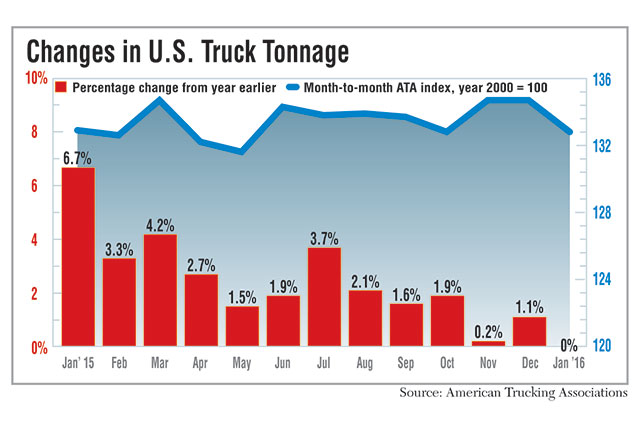Tonnage Index Drops 1.4%

Truck tonnage remained in the doldrums last month, falling 1.4% from December and showing no increase on a year-over-year basis as inventory and winter weather weighed down the results, American Trucking Associations reported.
The advanced index of for-hire freight was 132.8 in January, ATA said Feb. 23. December’s index was 134.7, after annual statistical revisions to reflect seasonal adjustments. That number matches the record high, which also was attained in November.
January’s tonnage reflects slow-moving freight market growth, which improved about 1.7% in the second half of last year after climbing at a pace exceeding 4% in the first half of 2015.
“Clearly, 2016 started soft for truck tonnage,” Bob Costello, ATA’s chief economist, said in a statement. “The winter storms that hit in January likely suppressed volumes some, but by falling 1.4%, I doubt tonnage would have been positive without the storms. That tells me that the inventory situation continues to weigh on truck freight volumes. The sooner the supply chain cleans out the excess stocks, the better for trucking.”
ATA also measures the non-seasonally adjusted tonnage, based on freight actually hauled by for-hire fleets. That number was 127.1 in January, 5.2% below the December result. In January 2015, the non-seasonally adjusted index was 127.0.
Weakness in the report reflected the commentary about freight markets from dozens of publicly held and privately owned fleets and logistics operators at investor conferences earlier this month, industry experts and the U.S. economy itself.
“What we are really seeing is that things aren’t changing,” Eric Starks, president of consultant FTR, told Transport Topics on Feb. 24. The economy and the trucking market are not “falling off the cliff or heating up. It’s really a mixed picture.”
“There is still a fair amount of pain to come in inventory adjustments,” Starks said, predicting that there won’t be the typical pickup in second-quarter freight above first-quarter levels.
Arun Raha, chief economist at Eaton Corp., termed ATA’s report “disappointing but not surprising,” in light of the sluggish U.S. economy in January, after a lackluster fourth quarter.
Factors such as continued weakness in energy exploration and the lack of a significant pickup in industrial production continue to weigh on capital investments and hurt trucking demand, both experts said.
“Businesses are very worried about what is happening on the global side of the economic equation,” Starks said.
Raha said the economy still hasn’t benefited from the expected stimulus of lower fuel prices, which now are about 40% below this time last year.
“Once the consumer gets their confidence back and starts spending, we will be fine,” Raha said. “But that hasn’t happened yet.”
Raha noted that the recent volatility in financial markets has been “very difficult to ignore,” both for consumers in terms of their confidence to increase their spending and for businesses’ investment decisions.
There are positives in the economy, Raha and Starks said, citing vehicle sales and housing.
The expected pickup in consumer spending should keep the United States on the same economic course this year of 2% to 2.5% GDP growth, which has been in place since the Great Recession ended, Raha said. Starks predicted the same pace.
The mixed economic environment will create “a little bit of pressure on trucking,” Starks said, though growth should continue to be slow and steady. FTR is forecasting 2% to 3% trucking volume growth, though tonnage could rise more slowly as more lower-weight cargo moves.
Costello also said January’s report hasn’t changed ATA’s 2% to 3% tonnage growth forecast for 2016, at least for now.
“We might end up reducing our 2016 outlook,” he told TT on Feb. 24. “I’ll wait until I see the February data; it is a possibility that I’ll reduce our expectations.”
ATA continues to expect a stronger second-half trucking market, he added.
Like Starks, DAT Solutions analyst Mark Montague said, “The number of loads haven’t dropped off the cliff. The overall tenor is soft.”
Spot market dry van freight has slowed, Montague said, due to soft demand and the inventory overhang.
On the other hand, contract refrigerated freight rates and volumes have been steady to support grocery companies. However, spot market reefer freight has been hurt by excessive rain in parts of California and Florida, where early season crops such as strawberries and melons have been hurt, he said.
“Lumber and construction materials are moving” to help housing, said Montague, who also noted strength in trucking to support the auto industry.
ATA’s January report reflected its annual revision and seasonal adjustment process, which is intended to present a clearer picture of ongoing business trends, Costello said. Before the revisions, January 2015 was the record month for truck tonnage, with December 2015 second.




